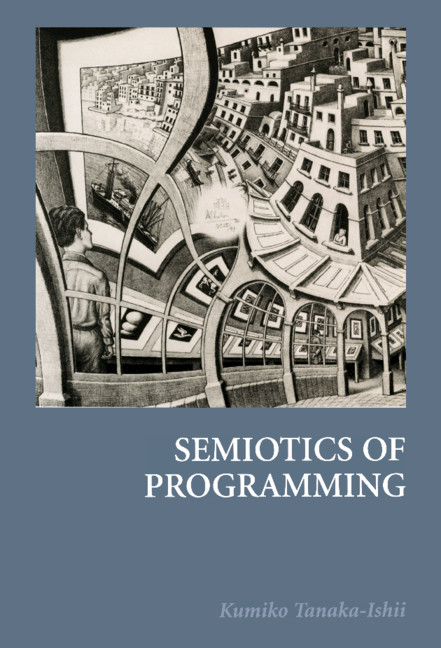
Title
SEMIOTICS OF PROGRAMMING
Size
228 pages, paperback
Language
English
Released
March, 2010
ISBN
9780521736275
Published by
Cambridge University Press
Book Info
See Book Availability at Library
Japanese Page
A sign is a means of signification, an entity that stands for something. For example, a sequence of letters, “computer,” stands for a particular type of electronic machine. As shown in this example, every word in a language is a sign. Furthermore, the scope of signs is much broader than just typical linguistic signs. For example, the melody of “Jingle Bells” can represent Christmas; therefore, the melody itself is a sign. Another example, which might not seem to be a sign, is “pain.” Pain usually indicates a dysfunction in the body; thus, it represents something and forms a sign. As Charles Sanders Peirce said, “Man is a sign.” People perceive objects via signs; therefore, signs are everywhere.
Semiotics is a field that studies the nature of signs. It was originally constituted by Ferdinand de Saussure and Peirce. In the beginning, semiotics theories mainly applied to natural language. The target of analysis was soon extended to include phenomena in which the meanings of elements are not as clear as in typical texts, including music, photography, film, the subconscious, animal behavior, and even spatiotemporal blanks. Today's information technology has increased the interest in semiotics because it represents human activity through signs with binary bits for processing on computers. A new academic trend in semiotics has, thus, been to apply semiotic theories to various sign phenomena that appear in information technology.
This book is a first attempt at applying the theories of semiotics to programming. Programming is foundational in information technology. While programming languages are based on rigorous theories of lambda calculus, semiotic theories have not yet been formally organized. Hence, the book attempts to reorganize the various existing theories of signs to make them applicable to programming theories. The study requires considering the correspondence between the theories of semiotics and lambda calculus. By applying Peircian and Saussurian theories of semiotics, the book presents a basic and general understanding of what a sign is.
The book consists of three parts. Part I discusses the nature of signs, describing how the meaning of a sign is produced by self-reference. This reflexive nature of a sign explains known properties of signs, such as their arbitrariness. Part II argues what kinds of signs exist by reorganizing the thoughts of Hjelmslev and Peirce on sign categories. Part III contemplates the nature of sign systems. A sign is self-referential; therefore, a sign system also naturally becomes reflexive.
The book has attracted significant attention for pioneering a theoretical and rigorous new approach to semiotics. Multiple book critiques have been published, as referred to on this page. Locally, the book has received two important prizes for writing achievement in humanities and information science.
(Written by TANAKA Kumiko, Professor, Research Center for Advanced Science and Technology / 2020)
Table of Contents
2. Computer signs in programs
Part I. Models of Signs:
3. The Babylonian confusion
4. Marriage of signifier and signified
5. Being and doing in programs
Part II. Kinds of Signs and Content:
6. The statement x := x + 1
7. Three kinds of content in programs
8. An instance vs. the instance
Part III. Systems of Signs:
9. Structural humans vs. constructive computers
10. Sign and time
11. Reflexivity and evolution
12. Conclusion.
Related Info
McGee, K. National University of Singapore, Singapore
Book review / Artificial Intelligence 175(5-6),930-931
https://www.sciencedirect.com/science/article/pii/S0004370211000129
John H. Connolly, Loughborough University, UK
Book review / Cambridge University Press
http://www.cambridge.org/us/catalogue/catalogue.asp?isbn=9780521736275
Marcel Danesi, University of Toronto
Book review / Cambridge University Press
http://www.cambridge.org/us/catalogue/catalogue.asp?isbn=9780521736275
Kyo Kageura, University of Tokyo
Book review / Cambridge University Press
http://www.cambridge.org/us/catalogue/catalogue.asp?isbn=9780521736275
Simon Thompson, University of Kent Canterbury, United Kingdom , Computing Reviews
Book review / Cambridge University Press
http://www.cambridge.org/us/catalogue/catalogue.asp?isbn=9780521736275
George Lazaroiu, Linguistic and Philosophical Investigations
Book review / Cambridge University Press
http://www.cambridge.org/us/catalogue/catalogue.asp?isbn=9780521736275
Rudy McDaniel, University of Central Florida
Book review / Cambridge University Press
http://www.cambridge.org/us/catalogue/catalogue.asp?isbn=9780521736275
Kumiko Tanaka-Ishii — Computational Semiotics Pioneer
https://medium.com/a-computer-of-ones-own/kumiko-tanaka-ishii-computational-semiotics-pioneer-51a4aaeab8ff
Wikipedia:
https://en.wikipedia.org/wiki/Computational_semiotics
Related Info:
“Semiotics of Computing : Filling the Gap Between Humanity and Mechanical Inhumanity”
In International Handbook of Semiotics, chapter 44, pages 981|1002,Springer, May 2015.
https://link.springer.com/chapter/10.1007/978-94-017-9404-6_44



 Find a book
Find a book


